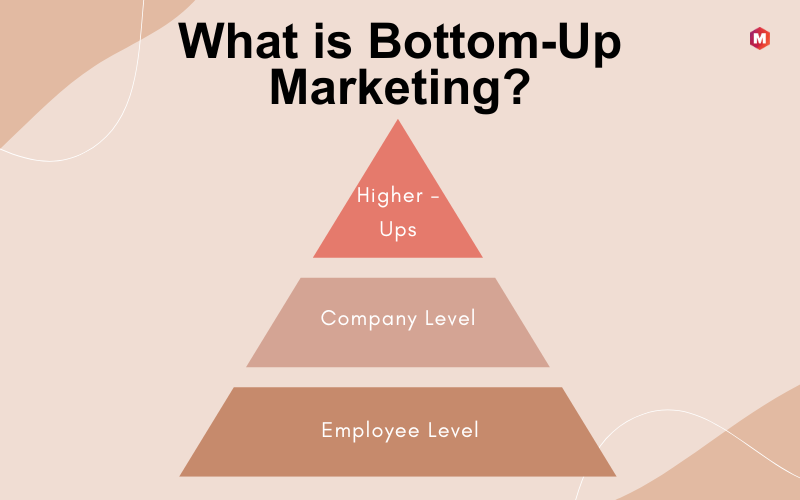Bottom-up marketing involves developing a marketing strategy within an organization by finding a workable tactic and then building on it to create a powerful strategy. According to this strategy, employees, rather than senior management, are responsible for knowing customers’ needs.
Conceptually developed by Ries and Trout (1989) in a popular book by the same name, bottom-up marketing is advocated by the authors as an alternative to traditional top-down marketing, which involves deciding what the firm wants to do (i.e., strategy) and then figuring out how to do it (i.e., tactics) (see top-down marketing).
Table of Contents
What is Bottom-Up Marketing?
Bottom-up marketing is a strategy that begins at the lowest level of an organization or team. It involves employees, departments, and divisions brainstorming ways to market their company’s products or services based on customer needs.
Bottom-up marketing strategies suggest that it is more logical for your employees to create the company’s marketing plan as they have direct customer interaction that helps them better understand what customers need and how to meet those needs.
Bottom-Up Marketing Examples
In support of the approach, Ries and Trout provide examples of organizations such as Federal Express, Microsoft, and Little Caesars, whose success is explained, according to the author’s research, by a bottom-up marketing approach.
An example of a bottom-up strategy Domino’s Pizza uses to create its strategy is ‘home delivery in 30 minutes, guaranteed.’ In further conceptualizing the approach, the authors consider tactics to be ‘competitive mental angles’ and strategies as ‘coherent marketing directions.’
What is Top-Down Marketing?
In a top-down approach, the senior management of a company would decide what marketing tactics should be used to promote its product or services. It is understood as the traditional marketing strategy that marketing teams used to prefer.
The plans and strategies are then passed down the chain of command until they reach the lower-level employees. The problem with the top-down approach is that those at the top may need more direct customer interaction than those at the lower levels, resulting in less effective marketing tactics.
Pros and Cons of Top-Down Marketing
With a top-down promotion strategy, you might get the following benefits as well as downsides –
Pros
- Structured approach: A top-down approach has a clear plan and structure, making coordinating efforts easier.
- Faster implementation time: Decisions can be made quickly without consulting the entire team.
- There is less risk of churn when the PoC leaves. Decisions are made from the top, so customers aren’t as likely to feel disconnected even if the primary point of contact (PoC) leaves.
Cons
- Lack of customer and product knowledge: Those at the top may need more direct customer interaction, resulting in less effective marketing tactics.
- Needs intensive resources: With less specialization, allocating the resources required for an effective top-down marketing strategy can take time and effort.
- Decreased engagement and morale: Employees may become disengaged in the marketing process without the opportunity to contribute.
- Tight alignment between sales and marketing is inevitable: The two must be aligned for the strategy to succeed.
Pros and Cons of Bottom-Up Marketing
Pros
- Better customer knowledge: Employees interacting with your customers daily are more likely to understand their needs and wants.
- More creative and innovative ideas: Employees familiar with the customer base are likely to develop more creative ways of marketing your product.
- Better engagement and morale: When employees have a say in how their company is marketed, they are more likely to be engaged in the process, boosting staff morale.
Cons
- Lack of structure: A clear plan or structure can help teams coordinate their efforts effectively.
- Slower implementation time: When everyone works independently, it takes longer to implement strategies.
- When the primary point of contact (PoC) leaves, the risk of churn increases: When the same PoC has been managing customer relationships, their departure can result in an increase in churn as customers may no longer feel personally connected to the company.
Comparing Top-down vs. Bottom-up Marketing Approaches
Below is a comparative table outlining the differences between top-down and bottom-up marketing strategies:
| Aspect | Top-Down Marketing Approach | Bottom-Up Marketing Approach |
|---|---|---|
| Decision-Making | Centralized; led by top management | Decentralized; led by specialized teams |
| Organizational Size | Suited for larger corporations | Favored by smaller, more agile companies |
| Audience Scope | Broad reach, less targeted | A highly targeted, engaged audience |
| Goals and Objectives | Focus on wide-reaching influence | Emphasis on adaptability and market alignment |
| Flexibility | Less flexible, controlled branding | More flexible, responsive to market changes |
| Marketing Alignment | May lack tactical response; strong messaging | Aligns closely with tactical market dynamics |
| Strategy Adoption | Uniform execution of strategy across levels | Strategy shaped by team insights |
Top-Down vs Bottom-Up Marketing: Which One should you choose for your business?
Many businesses today focus on marketing themselves from the top down, especially regarding advertising. They concentrate so much on the top executives who sit in swinging chairs behind big desks and wear expensive suits all day.
Today, the consumer market is tired and fed up with top-down advertising. Today’s target consumers expect advertising to help them relate to the promoted product or service. They want to relate to ideas, concepts, and persons featured in an advertisement. The top-down marketing system needs to help achieve this. Consumers need to identify with the big man behind the big chair. For this reason, businesses today are shifting focus, and too they are doing it rapidly.
“Here is something you should know as a marketer: the top-down marketing is designed to make the big man feel good. As much as his marketing team knows that the techniques and ideas adopted for an ad are not good, they still go ahead to impress the big guy.”
After all, the big man runs the company, likes the advert, and wants to be a part of it. Even though the idea isn’t the best regarding advertising, the marketing team features the big guy in the advert to stroke his ego.
It all doesn’t make sense unless you are looking for perfectly wrong sense (what’s that?)
Effective marketing should be all-inclusive, and successful companies should follow this. It should focus on the people, the target market, and what the business achieves in the long run. It has to ensure that a company meets its bottom line. In this regard, bottom-up marketing is what you should be thinking of; this is the approach you should be taking in marketing your products.
You need to use people with whom your target market can identify. People who build your brand and toil hard to ensure that your bottom line is achieved at the end of each financial year. These are people who guarantee that products are made available and that they meet the market’s expectations. For effective marketing, you should show these people in your marketing ads.
Why? Well, it’s pretty simple. As stated above, the audience you target needs to see advertisements that they can relate to. Therefore, using the group of people mentioned in the parish before this does not work in top management positions, the same way a more significant percentage of your target audience doesn’t (You should know that in any firm or company, less than 10% of the employees are in management positions).
Following top-down marketing will not help your business achieve its bottom line. It is sheer ignorance and a waste of resources. Unless you have some other hook that can catch the public’s attention, focus on using the people on the frontlines.
“In all this, we are not saying that a top-down marketing strategy is wrong. But as much as it is still a move that can be taken, bottom-up marketing is more efficient in most cases, particularly where recurrent, fast-moving products are concerned.”
Bottom-up marketing makes more sense, is more reliable, and won’t just be a waste of money. Because, after all, 90% of advertising is usually aimed at the general public, where very few people work in top-level management or executive positions.
As you adopt a strategy for your marketing campaigns, ensure that you do so while keeping in mind consumers’ needs and expectations.
Successful brands usually start from the bottom up, involving their entire organization in marketing efforts. Then, they blend it with top-down marketing to create a powerful message that resonates with the public. After all, the people on the frontline can best relate to the customers and their needs!
Bottom-up marketing analyzed: Case studies.
Here are two detailed case studies about businesses that successfully implemented bottom-up marketing strategies:
- Starbucks
Starbucks is a great example of a business that markets itself from the bottom up. Customers can share their thoughts and ideas on a website run by the company called “My Starbucks Idea.” They can also vote on other people’s ideas. After that, Starbucks sorts the ideas and puts the best ones into action.
This way, the business can ensure that its experiences and goods align with what customers want and need. Because of this stage for customer-driven ideas, Cake Pops, Hazelnut Macchiatos, and even free WiFi are now accurate.
- LEGO Ideas
LEGO uses a similar method with “LEGO Ideas,” a website where fans can share their ideas for LEGO sets. Other users can back these ideas; if 10,000 people do, the company will officially look at it. Once the review is done, the set is sold worldwide, and the person who made it gets credit, a cut of the sales, and other benefits. This “bottom-up” approach to finding and marketing new goods has led to several successful and unique LEGO sets, which shows how powerful their customers are.
Starting from what customers want and need, these two examples show how a bottom-up method can lead to successful marketing plans and creative new products.
Liked this post? Check out the complete series on Marketing


Hi.. I want to have some knowledge about bottom up marketing segmentation. can you please guide.?